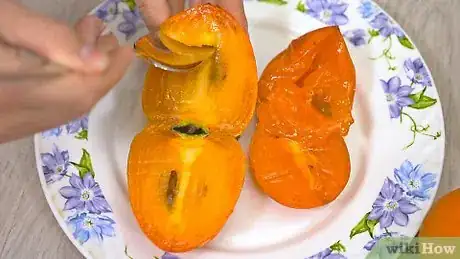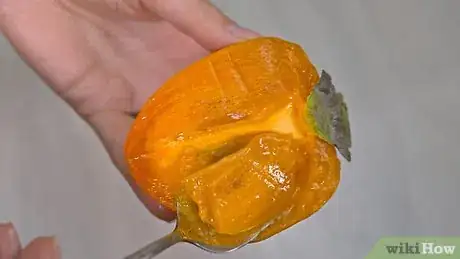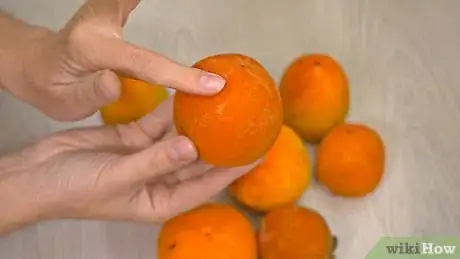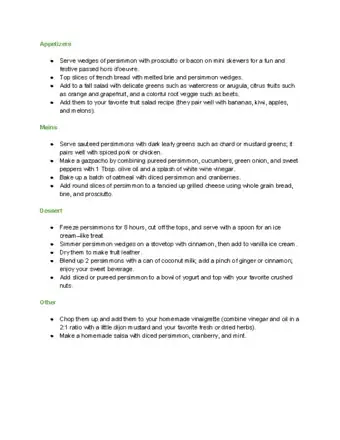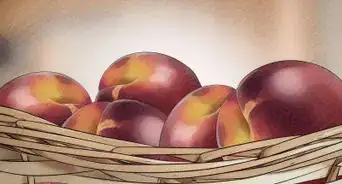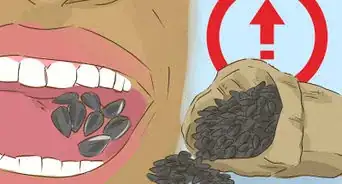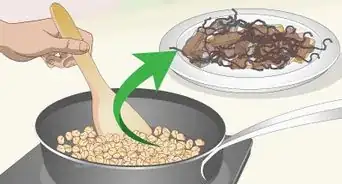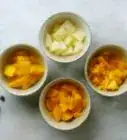wikiHow is a “wiki,” similar to Wikipedia, which means that many of our articles are co-written by multiple authors. To create this article, 69 people, some anonymous, worked to edit and improve it over time.
There are 17 references cited in this article, which can be found at the bottom of the page.
wikiHow marks an article as reader-approved once it receives enough positive feedback. This article received 44 testimonials and 86% of readers who voted found it helpful, earning it our reader-approved status.
This article has been viewed 3,113,631 times.
Learn more...
Persimmons, also called Sharon fruit, mature late in fall and can stay on trees until winter. This sweet, slightly tangy fruit has two main varieties–“astringent” and “non-astringent”–and the variety affects how ripe the fruit needs to be before you can eat it. We’ll teach you how to eat a persimmon and give you ideas on how to include this fruit in other meals, as well as how to identify whether a persimmon is ripe.
Steps
Sweet Persimmons
-
1Confirm the persimmon is sweet and non-astringent. Sweet persimmons are typically tomato-shaped, and often sold under the name Fuyu in the West. If your persimmon does not match this description, read the ID guide at the bottom of this article. You won't enjoy it if you follow these instructions with the wrong type of persimmon.
-
2Check whether the persimmon is ripe. You can tell a persimmon is ripe when it's firm and orange or deep orange-red. Sweet persimmons taste best when they're crisp.[1]
- A yellow persimmon is edible, but not fully ripe.
- Do not eat an unripe green persimmon. Green persimmons will always taste astringent (whether they're of the sweet variety or astringent variety).[2]
- You can eat persimmons overripe as well, with a spoon.
Advertisement -
3Wash the persimmon. Rub the persimmon clean under running water. The peel is edible, so wash it thoroughly.
-
4Cut off the leaves and slice. Using a sharp knife, cut off the leaf-like flower and stem. Slice the persimmon into thin wedges or slices, as you would a tomato.
- The skin is edible and usually thin. If you prefer to peel it, briefly immerse the whole fruit in hot water. Remove with tongs, then peel. This is the same process as blanching tomatoes.
-
5Eat the persimmon raw. A sweet persimmon should be firm and crisp, with a sweet flavor. If there are seeds, remove and discard them.
- Try adding lemon juice, or cream and sugar.[3]
- For more uses, check out the recipes below.
Astringent Persimmons
-
1Let your astringent persimmon ripen completely. Astringent persimmons are usually acorn-shaped and labeled "Hachiya," at least outside of Asia. They must be eaten when soft, practically bursting into mush.[4] The skin should be smooth and semi-translucent, with a deep orange color.
- Read the identification guide above if you're not sure about your persimmon type.
- If you eat Hachiya persimmon before it is completely ripe, you will have the strongest mouth puckering experience of your life, due to its astringency.[5] [6] This numb feeling is temporary. Drinking and eating other food will help it go away.
-
2Speed up the ripening process. Astringent persimmons ripen within 7–10 days of purchase, but can sometimes take a full month. To speed ripening, store in a closed paper bag or airtight container.[7] If stored in an airtight container, it may become moldy. Add a ripe apple, pear, or banana to the paper bag or container, or add a few drops of rum or other spirits on each of the leaf-like growths.[8]
- To ripen these without causing extreme mushiness, wrap each fruit in three layers of non-porous plastic wrap. (Avoid wraps labeled with recycling symbol 4 or "LDPE"). Heat in an oven at minimum temperature or with just the pilot light on, no more than 120ºF (50ºC). Leave for 18–24 hours, checking occasionally.[9]
-
3Eat the fruit chilled, with a spoon. Once the fruit is soft, pop it in the refrigerator. When you're ready to eat it, cut off the leaf-like flower stem, then slice lengthwise. Scoop out the seeds and inner stem if present. Eat the remaining fruit with a spoon.[10]
- The peel is edible as well, but eating it is messy when the fruit is ripe.
- Some people add cream and sugar, or a squeeze of lemon juice.
-
4Use shortcuts to eat unripe persimmons. There are a few tricks you can use to remove the astringency of an unripe persimmon. These will change the taste and texture, but you won't have to wait days before eating the fruit:
- Freeze the soft fruit instead to create a sorbet-like texture. If you prefer it warm, defrost it in the microwave.
- Alternatively, soak the persimmon in salt water for about a minute.
Cooking with Persimmons
-
1Add sweet persimmons to salad. Firm, crisp sweet persimmon works wonderfully in both fruit salads and green salads. Add it to autumn salads that include nuts, cheese, or pomegranate, or try this unique recipe:[11]
- Toast peeled hazelnuts in a dry pan until aromatic, about 12–15 minutes.[12]
- Cut fennel into thin slices.
- Slice the persimmon(s) into quarters, then into thin slices. Toss with hazelnuts and fennel.
- Top with grated Parmesan and a white wine vinaigrette. Add salt if necessary to balance the sweetness.
-
2Make a sweet persimmon salsa. Chop sweet persimmons roughly. Toss with standard salsa ingredients, such as red onion, cilantro, and chili peppers.[13] If you don't have a favorite sweet salsa, follow this recipe and replace the mango and the tomatoes.
-
3Make jam. You can cook persimmons into a jam as you would any fruit. For best results, use soft, astringent varieties, and taste each fruit before adding it to the pot. Even one astringent persimmon will add significant off-flavors.[14]
- Optionally, add cinnamon, nutmeg, and/or orange zest.
- Peel the fruit before stewing.
-
4Add ripe fruits to dessert. Soft, ripe persimmons of either type are perfect for desserts. Mix the persimmon with yogurt or ice cream, or explore these options:
- Puree the flesh and blend with cream cheese, orange juice, honey and salt.[15]
- Replace the apricot in this sorbet recipe.
- Bake them into cakes or cookies. The easiest way to find the right amount is to use a recipe that calls for overripe bananas, and replace them with an equal quantity of persimmon.[16] Try banana bread or banana muffins. Baking soda will reduce astringency and thicken the pulp, but also reacts with persimmon to make the batter very light and airy.[17] Halve the amount or skip it completely if you want a dense bread.
Identifying Persimmons
-
1Examine the shape. Its shape is usually enough to identify persimmons sold in Western countries. Nibble cautiously if this is your only guideline, especially in East Asia where there are many varieties with all sorts of shapes.
- Most sweet persimmons are squat with a flat base, similar in shape to a tomato. Some have slight indented lines running from the stem to the base, while others are smooth.
- Most astringent persimmons are longer and taper to a blunt point, similar in shape to an oversize acorn.
-
2Check the variety name. In the West, persimmons are sold under just two names. Fuyu persimmons are sweet (non-astringent), and are eaten when firm. Hachiya persimmons are astringent when unripe, and can only be eaten when completely soft. Some stores in East Asia will distinguish between many more types:
- Other sweet varieties include Jiro, Izu, Hanagosho, Midia, Suruga, and Shogatsu, plus any variety ending in "Maru," "Jiro" or "Fuyu."[18]
- There are dozens of astringent varieties. Tanenashi, Eureka, Tamopan, and Gailey are a few of the most common.[19] [20] When in doubt, assume the fruit is astringent.
-
3Look for defects or special shapes. If you're still stuck, the shape or growth pattern of the fruit can provide hints. Many persimmons won't have these distinguishing marks, but it's worth a look:
- American persimmons or "possum apples" are native to the eastern United States. These are typically very small and harvested from wild trees. These are astringent.[21]
- A persimmon with four sides to it is astringent.
- A persimmon with concentric rings around the flower end (which looks like leaves) is probably astringent.
- A persimmon with cracks near the flower end is usually sweet, or a rotten fruit of either type.
-
4Consider special varieties. A few varieties have special characteristics to consider:
- Triumph persimmons (also called Sharon fruit) often taste sweet when sold commercially, due to special treatment.[22] Straight from the tree, this is an astringent variety. (And be careful — in some regions, all persimmons are called Sharon fruit.)
- Some varieties are astringent if the inside is seedless and light-colored. They transform into sweet, seeded, dark flesh if pollinated. These include Chocolate, Giombo, Hyakume, Nishimura Wase, Rama Forte, and Luiz de Queiroz varieties.[23]
- Hiratanenashi persimmons, common in Japan, can stay astringent even when soft and ripe. Proper handling prevents this, so buy from a vendor you trust.
Recipe Ideas
Community Q&A
-
QuestionAre persimmons good for you?
 wikiHow Staff EditorThis answer was written by one of our trained team of researchers who validated it for accuracy and comprehensiveness.
wikiHow Staff EditorThis answer was written by one of our trained team of researchers who validated it for accuracy and comprehensiveness.
Staff Answer wikiHow Staff EditorStaff AnswerPersimmons have a decent amount of fiber, and significant amounts of Vitamins A and C, as well as manganese and some other nutrients in smaller amounts. There are also antioxidants in persimmons which may have some positive health effects. Unless you must closely regulate your sugar intake due to a condition like diabetes, persimmons can easily be part of a healthy diet.
wikiHow Staff EditorStaff AnswerPersimmons have a decent amount of fiber, and significant amounts of Vitamins A and C, as well as manganese and some other nutrients in smaller amounts. There are also antioxidants in persimmons which may have some positive health effects. Unless you must closely regulate your sugar intake due to a condition like diabetes, persimmons can easily be part of a healthy diet. -
QuestionWhat are the health benefits of persimmons?
 wikiHow Staff EditorThis answer was written by one of our trained team of researchers who validated it for accuracy and comprehensiveness.
wikiHow Staff EditorThis answer was written by one of our trained team of researchers who validated it for accuracy and comprehensiveness.
Staff Answer wikiHow Staff EditorStaff AnswerPersimmons are a relatively good source of fiber and an excellent source of Vitamin A. Some antioxidants and nutrients found in persimmons may have a positive effect on preventing heart disease and supporting the health of the eye, though the exact effects of these compounds or of eating persimmons on your health is difficult to say.
wikiHow Staff EditorStaff AnswerPersimmons are a relatively good source of fiber and an excellent source of Vitamin A. Some antioxidants and nutrients found in persimmons may have a positive effect on preventing heart disease and supporting the health of the eye, though the exact effects of these compounds or of eating persimmons on your health is difficult to say. -
QuestionCan you eat the skin on a persimmon?
 wikiHow Staff EditorThis answer was written by one of our trained team of researchers who validated it for accuracy and comprehensiveness.
wikiHow Staff EditorThis answer was written by one of our trained team of researchers who validated it for accuracy and comprehensiveness.
Staff Answer wikiHow Staff EditorStaff AnswerYes, as long as the persimmon you're eating is ripe, it should be fine. However, the skin can be more bitter and astringent than the rest of the fruit, so you might not like it as much. If you bite into an astringent persimmon that is not ripe, the skin will be incredibly bitter and this will be an experience you will not soon forget!
wikiHow Staff EditorStaff AnswerYes, as long as the persimmon you're eating is ripe, it should be fine. However, the skin can be more bitter and astringent than the rest of the fruit, so you might not like it as much. If you bite into an astringent persimmon that is not ripe, the skin will be incredibly bitter and this will be an experience you will not soon forget!
Warnings
- In rare cases, persimmons contribute to bezoars, or lumps that block the digestive tract. Eat them only in small quantities if you have digestive issues, or if you have had gastric bypass surgery.⧼thumbs_response⧽
- At least one person has reported dizziness and vomiting from eating persimmon seeds.[25] . Traditionally, the seeds are ground and roasted as a way to stretch coffee supplies. To be safe, try this in small quantities only, and do not eat the seeds raw.⧼thumbs_response⧽
- Never feed persimmons to animals. They may cause digestive blockage, and the seeds are especially dangerous to dogs, horses, and other species.[26] [27]⧼thumbs_response⧽
Things You'll Need
- Chopping board and knife
- Blanching bowl and hot water if removing peel
- Vegetable washing liquid
References
- ↑ http://www.thekitchn.com/whats-the-deal-11-14145
- ↑ http://www.growables.org/information/TropicalFruit/persimmonvarieties.htm
- ↑ http://www.hort.purdue.edu/newcrop/morton/japanese_persimmon.html
- ↑ Larousse Gastronomique, Persimmon, p. 779, (2009), ISBN 978-0-600-62042-6
- ↑ http://www.theoldfoodie.com/2007/10/puckering-up-with-persimmons.html
- ↑ http://www.persimmonpudding.com/harvest/ripeness.html
- ↑ http://redwoodbarn.com/DE_persimmonpucker.htm
- ↑ http://www.ukfoodguide.net/persimmon.htm
- ↑ http://redwoodbarn.com/DE_persimmonpucker.htm
- ↑ http://www.ukfoodguide.net/persimmon.htm
- ↑ https://www.theawl.com/2014/11/eat-the-persimmon/
- ↑ http://www.mybakingaddiction.com/how-to-toast-nuts-tutorial/
- ↑ http://www.thekitchn.com/whats-the-deal-11-14145
- ↑ http://www.seasonaleating.net/2012/01/preparing-hachiya-persimmons.html
- ↑ http://www.hort.purdue.edu/newcrop/morton/japanese_persimmon.html
- ↑ http://www.eattheweeds.com/persimmons-pure-pucker-power-2/
- ↑ http://www.exploratorium.edu/cooking/icooks/02-05-04.html
- ↑ http://articles.latimes.com/2000/nov/08/food/fo-48529
- ↑ http://articles.latimes.com/2000/nov/08/food/fo-48529
- ↑ http://www.hort.purdue.edu/newcrop/morton/japanese_persimmon.html
- ↑ http://articles.latimes.com/2000/nov/08/food/fo-48529
- ↑ http://www.specialtyproduce.com/produce/Sharon_Fruit_2577.php
- ↑ http://www.growables.org/information/TropicalFruit/persimmonvarieties.htm
- ↑ http://www.theoldfoodie.com/2007/10/puckering-up-with-persimmons.html
- ↑ http://www.eattheweeds.com/persimmons-pure-pucker-power-2/
- ↑ http://www.eattheweeds.com/persimmons-pure-pucker-power-2/
- ↑ http://www.mercurynews.com/animal-life/ci_26787326/persimmon-loving-dog-at-risk
About This Article
The easiest way to eat a sweet persimmon is to slice the persimmon in half and eat it raw. Add lemon juice, cream, or sugar to emphasize the persimmon’s sweetness. Check if your persimmon is ripe making sure it’s a deep orange color and always wash before eating. To cook with persimmons, or eat astringent persimmons, continue reading below!

